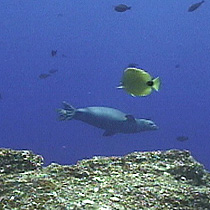2007年VOA标准英语-Endangered Hawaiian Monk Seal Population Contin(在线收听)
Hawaii
11 June 2007
Monk seals are one of the most endangered mammals in the world. In the Caribbean, they already are extinct. Off the African coast of Mauritania, they are down to a few hundred. In the remote northwestern islands of Hawaii, their numbers are quickly dwindling. Producer Zulima Palacio went to Hawaii and examined the monk seals close up. Melinda Smith narrates the story.
 |
| A monk seal (background) swimming in the waters of Hawaii |
Anthropologist Joe Heakock is one of a handful of dive masters who take small groups to the remote waters near Niihau Island to see the seals. "A true seal is perfectly made for water, totally hydrodynamic and you see their little flippers do this little side to side switch thing… they are fast and beautiful."
For the past three years, Heakock has taken more than 1,000 divers to see the seals in their natural habitat along dramatic lava formations and vertical rock walls running 90 meters straight down. A solitary monk seal often stays close to the divers.
"Monk seals are the most endangered marine mammal we have in the United States, so there is a lot of concern about making sure that they will be around for future generations to see,” said Heakock. “But from what biologists are saying we may only have 12 to 15 years to enjoy them."
There were three groups of monk seals. But one has been extinct for more than 50 years in the Caribbean. A second group in the Mediterranean is down to a few hundred. Here in the northwestern Hawaiian Islands the numbers are rapidly falling.
Mimi Olry is Hawaii's Marine Conservation Coordinator. "The Hawaiian monk seals are really on a crisis stage now,” she says. “Their numbers are in the lowest they have ever been. They numbered about 1200 this year and we have been losing about four percent of the population since about 2000."
Until the early 1900s hunting dramatically reduced the monk seal population. And despite laws protecting them since 1972, a number of factors, including human activity, still keep them on the endangered list.
"The majority of seal loss is within the juvenile age of the pups not making it through the first and second year of age,” explains Olry, “primarily being because of lack of food supply. Other factors are shark predations and marine debris. These seals are getting entangle in floating nets and ropes and drowning basically."
Local and national authorities are trying multiple approaches to protect the seals. One is posting signs on public beaches where the seals often rest and give birth.
"And here it informs people that seals may bite and cause serious injury,” says Olry, and that they are one of the most endangered species in the world and that they rest on the beach and we ask people not to disturb them."
Many scientists believe that the seals evolved from terrestrial mammals about 15 million years ago. But their time left could be numbered unless efforts to save them are successful.